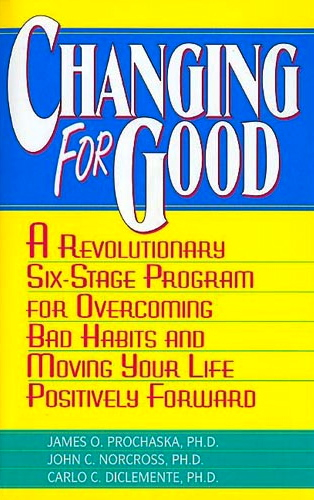By Prochaska, Norcross, and DiClemente
 After decades of clinical research, Prochaska, Norcross & DiClemente discovered a consistent process that successful “self-changers” use to overcome bad habits. One way they were able to identify this process was by studying people who quit smoking on their own.
After decades of clinical research, Prochaska, Norcross & DiClemente discovered a consistent process that successful “self-changers” use to overcome bad habits. One way they were able to identify this process was by studying people who quit smoking on their own.
The six-stage program works for a wide range of behaviors, including addictions, psychological distress, and procrastination. People go through these stages at different rates.
- Precontemplation. People in this stage don’t recognize the problem. Here we find the drunk who “isn’t an alcoholic,” the miserable person who is the last one to realize that she’s depressed, or the procrastinator who thinks he does his best work when challenged by a last-minute deadline.
- Contemplation. A person realizes that she has a problem, but she is not yet committed to taking the necessary actions to fix it. “Someday” she’ll quit smoking or drinking. “Someday” he’ll start working on projects before the last minute.
- Preparation. Just like it sounds, during this stage the would-be changer makes plans. Here’s how she’ll count calories. This is what he’ll do to avoid those all-night fire drills. She sets a date in the near future when she’ll start the change in earnest.
- Action. Now we remove all the brownie mix from the pantry, the beer from the house, the games from the work computer. We also counter temptations with healthy responses. In fact, you’ll find a great list of things we can to do to help ourselves move in the desired direction. Here is one of my favorite quotes:
Omitting exercise from a self-change plan is like fighting a foe with one hand tied behind your back. You may still win, but the odds are against you.
- Maintenance. This is the potentially long or on-going stage where the person who lost those 30 pounds keeps them off and the ex-smoker continues not to smoke. For some people and some habits, this stage continues for the rest of their lives.
- Termination. At this point, a person has achieved a new self-image. He is no longer tempted to revert. Some smokers, for example, quit smoking and eventually have no desire to smoke ever again. They don’t have to think about it or work to counter an urge to smoke. They’ve reached the termination stage. But other ex-smokers want a cigarette every day for the rest of their lives. Termination can be achieved for some people and some habits, but not for others.
For each stage, there are required actions. Jumping ahead may doom a change effort to failure. One reason many change efforts fail is that people try to do the work of a stage before they are ready. They may also fail to realize that lapsing need not be fatal to their change effort.
This book offers assistance with identifying the stage you are in, and then detailed chapters to help move through each stage. At the end of the book there is “A Changer’s Manual,” with examples from three specific problems that people often want to change: smoking, drinking, and psychological distress.
About 5% of people can quit a bad habit “cold turkey,” without using some form of this process. For the rest of us, the advice in this book can prevent a lot of trial and error, as well as a lot of lapsing and relapsing.
Resources
Book: Changing for Good
